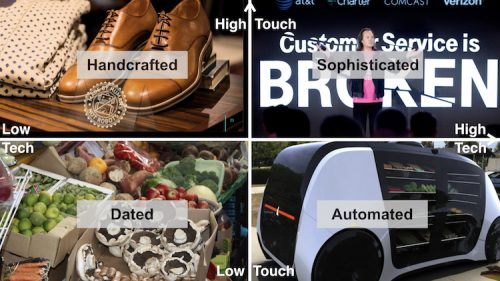
Recently I was lucky enough to have the chance to speak at the Customer Experience Innovation and Tech Fest in Pretoria, South Africa. There I was talking about the need for firms to take a more sophisticated approach to customer experience that would allow them to strike the right balance between the use of the human touch and technology.
This is something I’ve been musing on and calling for for a couple of years now ever since I wrote the article: The Need To (Re)Consider The Technology And Human Balance In Customer Experience.
It could be argued that nothing much has changed in that time and customers still complain about the lack of the human touch in the experiences that brands are developing. They are also not engaging with the digital and technological tools that brands are developing. At least, at a rate that those brands would like.
This latter idea is supported by data from Voxpro – powered by TELUS International who in a recent survey found that, on average, 68 percent of consumers had not yet used chatbots to get in touch with a brand.
That 68 percent rises to 78 percent for customers aged 65 and older. That’s not really a surprise but it does show that while overall adoption may be slower than many brands would like, younger generations are more willing to engage with automated systems.
Digging deeper into the 68 percent figure, Voxpro found that 56 percent of those consumers explained that they had not used chatbots or other automated tools because when it comes to accessing service they still prefer to engage with real people.
That does not mean that customers do not want to use these new tools. No.
Overall, Voxpro found that while there is appetite to use these new digital and AI-powered tools brands need to make sure that they must also be accompanied by human interaction.
To get that balance right brands have to answer a series of questions the answers to which will inform their journey mapping, channel development and technology buying decisions.
I believe the questions they need to answer are:
- What is your experience strategy and why?
- Is it high tech and low touch? Is it high touch and low tech? Is it low tech and low touch? Is it high tech and high touch?
- Where is your experience now and how would you like it to develop over time?
- How will it change for different types of customers? and
- Will it change depending on the stage of their journey?

Too few firms have considered these questions and that could be one of the main drivers behind why they are not getting the results they want from their customer experience efforts.
There are no easy answers to these questions as it will require firms to make choices about what to do and, more importantly, what not to do.
Many firms won’t do the work. And, will continue to be exasperated by the results that they get.
Others, however, will do the work and make the choices. They know that their customers are waiting.
As the poet Robert Frost once said in his poem ‘The Road Not Taken’:
Two roads diverged in a wood, and I,
I took the one less traveled by,
And that has made all the difference.
This post was originally published on Forbes.com here.
Thanks to Pixabay for the image.



